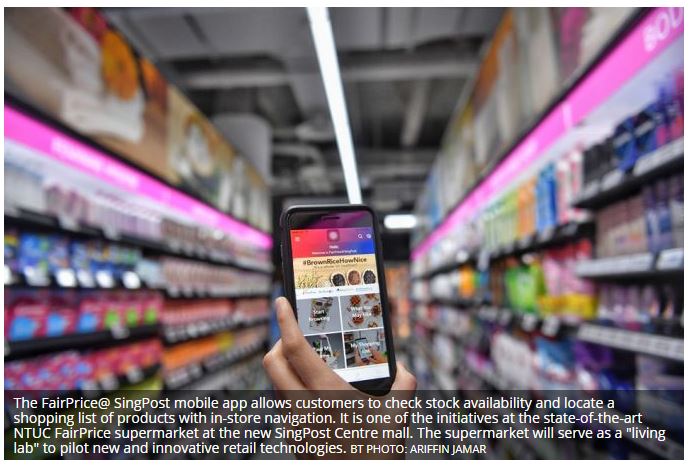Singapore retailers share tales of digitisation battles on the ground
SELF-CHECKOUT counters across 88 stores, a refreshed e-commerce platform, and an automated storage and retrieval system manned by robots.
Armed with a slew of digital initiatives, supermarket chain NTUC FairPrice is on a mission to “make data and technology key partners of the business”, said FairPrice’s managing director of digital and technology Johnny Wong.
But the firm’s race towards digitisation is often slowed by its internal trial and execution period, ranging from six months to a year, before changes can be rolled out.
This is due to the challenge of educating and re-training its staff to use new technology efficiently, said Mr Wong. “The world changes every few weeks and we can’t afford such long gestation periods anymore.”
As retailers in Singapore embark on the transformation journey, many face the struggle of getting their employees onboard.
In 2017, pet supplies chain Pet Lovers Centre introduced a system that automatically matches invoices to orders to eliminate the chore of manual data entry. An integrated payroll and time-clock system was also created to increase productivity in the human resource department.
While these initiatives were straightforward to implement, getting his staff to migrate over to the new systems proved the biggest hurdle, said Ng Whye Keong, director of Pet Lovers Centre.
“They were so used to the old way of doing things, especially the older workers and those who created the old systems,” he noted. “You can’t just introduce technology and think it’s going to be great from there, a lot of follow-up is needed.”
Similar concerns were voiced by Wahid Allapitchay, founder of local establishment Tash Tish Tosh in Kampong Glam.
When Mr Allapitchay revealed plans to implement an integrated point-of-sale (POS) system to streamline operations, he was met with indifference from staff.
He said: “People tend to be less receptive of change. When you tell them there’s a new system, their first instinct would be to frown upon it.”
The poor perception of retail jobs is a common reason for resistance towards re-training, said principal consultant Leonard Ling from Solutionsatwork.
He added: “Retail jobs have never been regarded well. Most frontline staff see it as a dead-end job so they are not motivated to learn.”
The challenge, he noted, lies in increasing employee value proposition. “They need to be empowered to realise they’re not just handling transactions, or waiting for time to pass in the store, but actually bringing value to someone with their service.”
Indifference towards change may also stem from insufficient knowledge about the benefits of new technology. This can be addressed by providing more exposure and hands-on training prior to implementation, said Solutionsatwork’s Mr Ling.
At Tash Tish Tosh, staff became more receptive towards the new POS system after using it for a period of time, said Mr Allapitchay.
“Their attitude completely changed after experiencing how the new system made their job easier,” he recalled. “I was afraid it was going to be a white elephant. If they didn’t use it – that’s money lost.”
A 2016 survey by Microsoft found that while 76 per cent of retailers in Asia Pacific believe they need to embrace digitisation for future growth, only 37 per cent have a full strategy in place. Empowering a digital workforce was identified as a key strategy for faster innovation and transformation.
Said Andres Ortola, director of enterprise commercial at Microsoft: “Emerging technologies will give organisations new capabilities to transform, but real transformation only happens when they bring their people along with them.”
SK Jewellery Group adopted 3D-printing technology to produce wax prototypes of its customised jewellery, shortening the turnaround time from three weeks to three days.
This was only possible because “our back-end could deliver,” said SK Jewellery’s executive director and group CEO Daniel Lim. Their jewellery designers, who used to do hand sketches, had to pick up computerised drawing skills.
Mr Lim added: “When you buy new technology, you need to ensure staff can use it well. Re-training is important, we don’t want to increase manpower for no reason.”
To enhance re-training efforts, retailers can turn to the various initiatives by the Singapore Retailers Association (SRA). One such programme is the Retail Job Redesign Framework, which offers step-by-step guides for companies to identify potential areas for job redesign, develop and deploy suitable solutions and measure the outcome.
Said SRA’s executive director Rose Tong: “It is imperative that there is clarity on job roles to bring about a motivated workforce.”
Employees must be willing to engage the customer and know how to do it well, she added.
Amid rapid advances of the technology frontier, FairPrice’s Mr Wong recognises the need to nurture a forward-thinking culture within the company to keep in tandem with digitisation efforts.
He hopes to achieve this by conducting frequent workshops and training sessions that involve the entire organisation, from frontline staff to senior leaders.
“Staff must develop a habit of challenging the status quo and constantly finding ways to improve so we can adapt at a faster pace,” he said. “If not, we’ll find ourselves left behind.”
Source: https://www.businesstimes.com.sg/government-economy/singapore-retailers-share-tales-of-digitisation-battles-on-the-ground


 English
English




